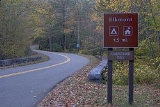
Elkmont, Tennessee
Encyclopedia
Elkmont is a region situated in the upper Little River
Valley of the Great Smoky Mountains
of Sevier County
, in the U.S. state of Tennessee
. Throughout its history, the valley has been home to a pioneer Appalachia
n community, a logging town, and a resort community. Today, Elkmont is home to a large campground, ranger station, and historic district maintained by the Great Smoky Mountains National Park
.
The Little River Lumber Company established the town of Elkmont in 1908 as a base for its logging operations in the upper Little River and Jakes Creek areas. By 1910, the company began selling plots of land to hunting and fishing enthusiasts from Knoxville
, who established the "Appalachian Club" just south of the logging town. In 1912, a resort hotel, the Wonderland Park Hotel
, was constructed on a hill overlooking Elkmont. A group of Knoxville businessmen purchased the Wonderland in 1919 and established the "Wonderland Club." Over the next two decades, the Appalachian Club and Wonderland Club evolved into elite vacation areas where East Tennessee's wealthy could gather and socialize.
Upon the creation of the national park in the 1930s, most of Elkmont's cottage owners were given lifetime leases. These were converted to 20-year leases in 1952, and renewed in 1972. The National Park Service refused to renew the leases in 1992, and under the park's general management plan, the hotel and cottages were to be removed. In 1994, however, the Wonderland Hotel and several dozen of the Elkmont cottages were listed on the National Register of Historic Places
as Elkmont Historic District, Great Smoky Mountains National Park, sparking a 15-year debate over the fate of the historic structures. In 2009, the National Park Service announced plans to restore the Appalachian Clubhouse and 18 cottages and outbuildings in the Appalachian Club area (which were older and more historically significant) and remove all other structures, including the Wonderland Annex (the main hotel had collapsed in 2005).
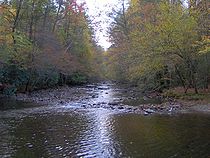 Elkmont is situated in a narrow but relatively flat valley created by the junction of Little River
Elkmont is situated in a narrow but relatively flat valley created by the junction of Little River
and Jakes Creek. Steep ridges surround the valley on all sides, with Meigs Mountain
rising to the west, Sugarland Mountain
rising to the east, and Cove Mountain rising to the north. To the south is Blanket Mountain, with the slopes of Clingmans Dome
and Mount Collins
beyond.
The source of Little River is approximately five miles above Elkmont along the slopes of Clingmans Dome, where it begins as a small trickle before its confluence with several smaller streams at an area known as Three Forks. In just over a mile, the river gains strength as it absorbs Meigs Post Prong, Rough Creek, and Fish Camp Prong before its junction with Jakes Creek at Elkmont. Just beyond Elkmont, the river turns sharply to the west toward its junction with Middle Prong at a popular swimming area known as the "Y".
Historically, Elkmont has been divided into three sections. The Wonderland Club section— the former location of the Wonderland Hotel and associated cottages— crowns a hill in the northeastern part of Elkmont. The section containing the Elkmont campground and ranger station— which was once home to the Little River Lumber Company logging town— is located at the center of Elkmont, north of the confluence of Little River and Jakes Creek. The Appalachian Club section is located primarily in the southern part of Elkmont, south of the confluence of Little River and Jakes Creek. The Appalachian Club section itself is divided into three smaller sections— "Daisy Town" between the mouths of Jakes Creek and Bearwallow Branch, "Society Hill" further south along the banks of Jakes Creek, and "Millionaires' Row" further east along the banks of Little River.
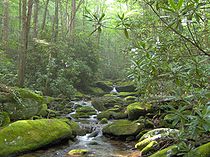 The first known permanent residents in what is now Elkmont settled along Jakes Creek in the 1840s. The creek's namesake, Jacob Hauser (c. 1791-1870), was probably the first to arrive. He was followed shortly thereafter by the family of David Ownby (1816-1889), who came to the area to search for gold. The small community that developed in the valley was known simply as "Little River". Like most Appalachia
The first known permanent residents in what is now Elkmont settled along Jakes Creek in the 1840s. The creek's namesake, Jacob Hauser (c. 1791-1870), was probably the first to arrive. He was followed shortly thereafter by the family of David Ownby (1816-1889), who came to the area to search for gold. The small community that developed in the valley was known simply as "Little River". Like most Appalachia
n communities, the residents of Little River developed a subsistence agricultural
economy. Most residents grew corn and apples and kept bees for honey. Several gristmill
s arose along Jakes Creek.
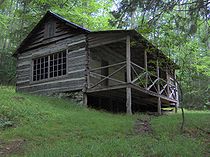 Only two structures remain from the pioneer period in Elkmont— the Avent cabin
Only two structures remain from the pioneer period in Elkmont— the Avent cabin
(constructed c. 1845) and the Levi Trentham cabin (constructed c. 1830). Originally built by the Ownby family, the Avent cabin was sold in 1919 to Nashville
artist Mayna Avent, who used it as an art studio until 1940. The Levi Trentham cabin was originally located in the upper reaches of Jakes Creek, and moved to the Appalachian Club's Daisy Town section in 1932 for use as a guest house.
Lem Ownby, David Ownby's legendary grandson, was born near Jakes Creek in 1889. In 1908, Ownby and his father built a cabin about a mile or so above the confluence of Jakes Creek and Little River where Ownby lived for the rest of his life. Ownby obtained a lifetime lease when the national park was established, and for several decades afterward sold honey to hikers. Among those who paid Ownby a visit were Tennessee governor (and later U.S. senator) Lamar Alexander
and U.S. Supreme Court justices Harry Blackmun
and Potter Stewart
. The Justices were visiting a prominent Knoxville lawyer, Foster Arnett, who wanted to introduce them to a real mountain man. Foster led the two Justices up the trail to meet Lem only to discover Lem would not meet the two men. When Foster knocked on Lem's door and announced that he had two Supreme Court Justices outside who wanted to meet him, Lem simply replied that they were not welcome to come in the cabin. Foster was very embarrassed while the two Justices folded over laughing. The two Justices loved that Lem had refused to meet them because it was the one person who would tell them no, something they seldom found. Reportedly the story was one shared for years among the Justices on the Supreme Court. Ownby died in 1984, the last of the park's lifetime lessees outside of Cades Cove.
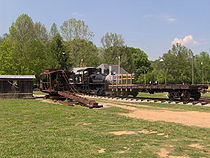 In the 1880s, Knoxville businessman John L. English began a small-scale logging project along Jakes Creek. To transport the logs to a sawmill on the outskirts of Knoxville, English constructed a series of splash dams along Little River. When the logs were ready to be moved, the floodgates of these dams were opened and the rushing torrent carried the logs downstream. While English managed a moderate profit, his venture had folded by 1900, possibly because of a disastrous flood along Little River in 1899.
In the 1880s, Knoxville businessman John L. English began a small-scale logging project along Jakes Creek. To transport the logs to a sawmill on the outskirts of Knoxville, English constructed a series of splash dams along Little River. When the logs were ready to be moved, the floodgates of these dams were opened and the rushing torrent carried the logs downstream. While English managed a moderate profit, his venture had folded by 1900, possibly because of a disastrous flood along Little River in 1899.
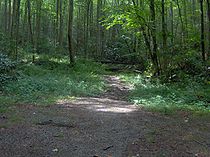 In 1901, Pennsylvania
In 1901, Pennsylvania
entrepreneur Colonel Wilson B. Townsend purchased 86000 acres (348 km²) of land along Little River and established the Little River Lumber Company. Townsend set up a band saw
mill in Tuckaleechee Cove, laying the foundation for the town that would later bear his name
. Rather than splash dams, which are at the mercy of the volatile mountain streams, Townsend constructed a logging railroad between the company's sawmill in Tuckaleechee and the river's upper reaches, all the way to the Three Forks area (where the river absorbs Fish Camp Prong and Rough Creek). The railroad was later extended to Walland
, connecting it to Maryville
and Knoxville. The railroad employed 10 Shay engines to move the log-filled flatcars along the river valley. Logging skidder
s were used to pull trees from the steeper slopes. Elkmont was established in 1908 as a transfer station where logs were moved from gear-operated trains (used for reaching higher elevations) to rod-operated trains for transport to the sawmill at Townsend.
Early Elkmont was a typical temporary logging camp. These camps bore a resemblance to later Depression-era shanty town
s. Shanty houses (or "set off" houses), a post office, a transient hotel, a commissary, and sheds critical to railroad maintenance were the town's only buildings. Many loggers lived in boarding houses, and some crossed Sugarland Mountain via a trail connecting Elkmont to the Sugarlands. As logging operations progressed, it became necessary to move the camp higher up the mountain slopes to the south. The company managed this by loading the shanties onto railroad flatcars and moving them to pre-constructed foundations using a logging crane. Although the logging camps moved, Elkmont remained the company's primary base of operations in the upper Little River valley.
In 1926, Townsend sold most of his Little River Lumber tract to the newly-created Great Smoky Mountains Park Commission, although he had been given permission to continue logging for most of the next decade. By the time the company ceased operations in 1939, it had produced 750 million board feet (1.8 million m³) of lumber. In the 1960s, the park service built the current campground over the site of the former logging town. Little remains from Elkmont's logging period, although three of the later resort cottages (including the Addicks and Mayo cabins) are believed to have been modified Little River Lumber Company shanty houses.
 In his company's early days, Townsend allowed hunters and fishermen to use the Little River Railroad to access the deep, game-rich forests of the Smokies. As the Elkmont valley was slowly stripped of its valuable timber, Townsend began to advertise the area as a mountain getaway. In 1909, Little River Railroad began offering the Sunday "Elkmont Special"— non-stop train service from Knoxville to Elkmont. In 1910, an affluent group of Knoxville hunting and fishing enthusiasts formed the Appalachian Club and purchased what is now "Daisy Town" south of the confluence of Little River and Jakes Creek. They built the Appalachian Clubhouse for use as a lodge. Within a few years, several clubmembers built cottages, and the club evolved into a mountain getaway for Knoxville's elite.
In his company's early days, Townsend allowed hunters and fishermen to use the Little River Railroad to access the deep, game-rich forests of the Smokies. As the Elkmont valley was slowly stripped of its valuable timber, Townsend began to advertise the area as a mountain getaway. In 1909, Little River Railroad began offering the Sunday "Elkmont Special"— non-stop train service from Knoxville to Elkmont. In 1910, an affluent group of Knoxville hunting and fishing enthusiasts formed the Appalachian Club and purchased what is now "Daisy Town" south of the confluence of Little River and Jakes Creek. They built the Appalachian Clubhouse for use as a lodge. Within a few years, several clubmembers built cottages, and the club evolved into a mountain getaway for Knoxville's elite.
 In 1911, Townsend gave Charles Carter several acres of land on a hill overlooking Elkmont with the stipulation that Carter build on it within one year. In 1912, Carter made good on the promise when he opened the Wonderland Hotel. Billed as a resort lodge, the hotel contained 50 rooms with an extensive balcony looking out over the valley and Meigs Mountain. As membership in the Appalachian Club proved remarkably difficult to obtain, several rejected Knoxvillians purchased the Wonderland Hotel site and formed the Wonderland Club in 1919. Along with the hotel, 10 or so cottages were erected on the hill.
In 1911, Townsend gave Charles Carter several acres of land on a hill overlooking Elkmont with the stipulation that Carter build on it within one year. In 1912, Carter made good on the promise when he opened the Wonderland Hotel. Billed as a resort lodge, the hotel contained 50 rooms with an extensive balcony looking out over the valley and Meigs Mountain. As membership in the Appalachian Club proved remarkably difficult to obtain, several rejected Knoxvillians purchased the Wonderland Hotel site and formed the Wonderland Club in 1919. Along with the hotel, 10 or so cottages were erected on the hill.
In 1925, Little River Lumber Company concluded its logging operations in the Three Forks area and sought to move the Elkmont tracks to the recently-acquired Walker Valley (now Tremont
). Fearing a lawsuit from cottage owners, Townsend ordered the tracks to be pulled up and moved in secret. Elkmont residents were outraged. Fortunately, however, the railroad grades were perfect for road construction. In 1926, thanks largely to Tennessee Governor Austin Peay
(who owned a cottage at Elkmont), a road was constructed connecting Townsend with both the Wonderland Club and Appalachian Club areas. During its construction, members of the Metcalf family, who owned a farm just west of Elkmont, supplied the workers with drinking water. In appreciation, a large picnic area between Elkmont and Wears Valley
was named Metcalf Bottoms.
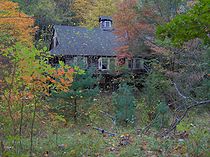 In 1920, Willis P. Davis and his wife Anne, who owned a summer cottage at Elkmont, began to suggest an idea for a national park
In 1920, Willis P. Davis and his wife Anne, who owned a summer cottage at Elkmont, began to suggest an idea for a national park
in the Smokies after a visit to Yellowstone
. While the Davises merely suggested the idea to influential friends in Knoxville, it was another Elkmont cottage-owner, David C. Chapman, who took the initiative. Business owners in Knoxville quickly saw the benefits of a national park and began lobbying federal and state governments.
After the U.S. government agreed to establish the national park if the states of Tennessee and North Carolina purchased the land, Knoxville began an intensive lobbying campaign aimed at the Tennessee legislature. In 1925, Chapman hosted a group of legislators at Elkmont to sell the park idea. The following year, Colonel Townsend made the initial 76000 acres (307.6 km²) sale.
While Elkmont was the birth of the park movement, it was also home to one of the strongest anti-park movements. Shortly after the Townsend purchase, an attorney for Little River Lumber Company named Jim Wright rallied a hodge-podge group of attorneys, businessmen, and mountaineers at Elkmont to propose the establishment of a national forest rather than a national park. Wright also proposed a massive road-building campaign across the crest of the Smokies in hopes of increasing the land's value. Largely because of Wright's efforts, the initial bill allowing for the purchase of land in the Smokies exempted Elkmont from eminent domain
. Cottage owners managed to gain a provision that allowed them to sell their cottages at half-price in exchange for lifetime leases.

Most of the lifetime leases on the Wonderland Hotel and the rustic cottages at Elkmont expired in 1992 (two expired in 2001), and ownership reverted to the National Park Service. The park's 1982 General Management Plan calls for all structures to be removed to allow nature to reclaim the affected areas. However, in 1994, the Wonderland Hotel and several of the rustic cottages were placed on the National Register of Historic Places
, giving them a special status. A debate immediately ensued over the fate of these structures.
In 2005, the Wonderland Hotel collapsed from a structural failure. Parts of the hotel deemed to have historical value were removed and the rest cleared, leaving only the annex and a chimney fall. In its 2009 Final Environmental Impact Statement for Elkmont, the National Park Service announced plans to restore the Appalachian Clubhouse and eighteen cabins in the Appalachian Club section. The remaining structures will be carefully documented and removed.
The Byers cabin— located south of Daisy Town in the Appalachian Club's Society Hill section, was also chosen for preservation, due largely to its association with early park promoter David Chapman. The Spence cabin, a large lodge in the Appalachian Club's Millionaires' Row section, is being restored and preserved primarily for its location at the head of the Little River Trail and its possibilities as a day use structure. All structures will be removed from the Wonderland Club section of Elkmont, and a kiosk will be placed on the site of the Wonderland Hotel to interpret the hotel's history.
Little River (Tennessee)
Little River is a scenic river in Tennessee which drains a area containing some of the most spectacular scenery in the southeastern United States. The first of the river are all located within the borders of the Great Smoky Mountains National Park...
Valley of the Great Smoky Mountains
Great Smoky Mountains
The Great Smoky Mountains are a mountain range rising along the Tennessee–North Carolina border in the southeastern United States. They are a subrange of the Appalachian Mountains, and form part of the Blue Ridge Physiographic Province. The range is sometimes called the Smoky Mountains or the...
of Sevier County
Sevier County, Tennessee
Sevier County is a county of the state of Tennessee, United States. Its population was 71,170 at the 2000 United States Census. It is included in the Sevierville, Tennessee, Micropolitan Statistical Area, which is included in the Knoxville-Sevierville-La Follette, TN Combined Statistical Area. The...
, in the U.S. state of Tennessee
Tennessee
Tennessee is a U.S. state located in the Southeastern United States. It has a population of 6,346,105, making it the nation's 17th-largest state by population, and covers , making it the 36th-largest by total land area...
. Throughout its history, the valley has been home to a pioneer Appalachia
Appalachia
Appalachia is a term used to describe a cultural region in the eastern United States that stretches from the Southern Tier of New York state to northern Alabama, Mississippi, and Georgia. While the Appalachian Mountains stretch from Belle Isle in Canada to Cheaha Mountain in the U.S...
n community, a logging town, and a resort community. Today, Elkmont is home to a large campground, ranger station, and historic district maintained by the Great Smoky Mountains National Park
Great Smoky Mountains National Park
Great Smoky Mountains National Park is a United States National Park and UNESCO World Heritage Site that straddles the ridgeline of the Great Smoky Mountains, part of the Blue Ridge Mountains, which are a division of the larger Appalachian Mountain chain. The border between Tennessee and North...
.
The Little River Lumber Company established the town of Elkmont in 1908 as a base for its logging operations in the upper Little River and Jakes Creek areas. By 1910, the company began selling plots of land to hunting and fishing enthusiasts from Knoxville
Knoxville, Tennessee
Founded in 1786, Knoxville is the third-largest city in the U.S. state of Tennessee, U.S.A., behind Memphis and Nashville, and is the county seat of Knox County. It is the largest city in East Tennessee, and the second-largest city in the Appalachia region...
, who established the "Appalachian Club" just south of the logging town. In 1912, a resort hotel, the Wonderland Park Hotel
Wonderland Hotel
The Wonderland Hotel was a hotel built in 1911 at Elkmont, Sevier County, Tennessee by the Wonderland Club Company and was dismantled and partially preserved in 2006 by the National Park Service.-History:...
, was constructed on a hill overlooking Elkmont. A group of Knoxville businessmen purchased the Wonderland in 1919 and established the "Wonderland Club." Over the next two decades, the Appalachian Club and Wonderland Club evolved into elite vacation areas where East Tennessee's wealthy could gather and socialize.
Upon the creation of the national park in the 1930s, most of Elkmont's cottage owners were given lifetime leases. These were converted to 20-year leases in 1952, and renewed in 1972. The National Park Service refused to renew the leases in 1992, and under the park's general management plan, the hotel and cottages were to be removed. In 1994, however, the Wonderland Hotel and several dozen of the Elkmont cottages were listed on the National Register of Historic Places
National Register of Historic Places
The National Register of Historic Places is the United States government's official list of districts, sites, buildings, structures, and objects deemed worthy of preservation...
as Elkmont Historic District, Great Smoky Mountains National Park, sparking a 15-year debate over the fate of the historic structures. In 2009, the National Park Service announced plans to restore the Appalachian Clubhouse and 18 cottages and outbuildings in the Appalachian Club area (which were older and more historically significant) and remove all other structures, including the Wonderland Annex (the main hotel had collapsed in 2005).
Geography

Little River (Tennessee)
Little River is a scenic river in Tennessee which drains a area containing some of the most spectacular scenery in the southeastern United States. The first of the river are all located within the borders of the Great Smoky Mountains National Park...
and Jakes Creek. Steep ridges surround the valley on all sides, with Meigs Mountain
Meigs Mountain Trail
The Meigs Mountain Trail is an American hiking trail in the Great Smoky Mountains National Park of Sevier County, Tennessee. The trail traverses the northern slopes of Meigs Mountain in the northwest section of the park, connecting Jakes Creek in the Elkmont area with Lumber Ridge in the Tremont area...
rising to the west, Sugarland Mountain
Sugarland Mountain Trail
The Sugarland Mountain Trail is an American hiking trail, in the Great Smoky Mountains National Park of Sevier County, Tennessee. The trail traverses Sugarland Mountain, a massive ridge running perpendicular to the main crest of the Smokies and effectively dividing the park's north-central section...
rising to the east, and Cove Mountain rising to the north. To the south is Blanket Mountain, with the slopes of Clingmans Dome
Clingmans Dome
Clingmans Dome is a mountain in the Great Smoky Mountains of Tennessee and North Carolina, in the southeastern United States. At an elevation of , it is the highest mountain in the Smokies, the highest point in the state of Tennessee, and the highest point along the Appalachian Trail...
and Mount Collins
Mount Collins
Mount Collins is a mountain in the Great Smoky Mountains, located in the Southeastern United States. It has an elevation of above sea level. Located along the Appalachian Trail between Clingmans Dome and Newfound Gap, the mountain is a popular destination for thru-hikers. A backcountry shelter...
beyond.
The source of Little River is approximately five miles above Elkmont along the slopes of Clingmans Dome, where it begins as a small trickle before its confluence with several smaller streams at an area known as Three Forks. In just over a mile, the river gains strength as it absorbs Meigs Post Prong, Rough Creek, and Fish Camp Prong before its junction with Jakes Creek at Elkmont. Just beyond Elkmont, the river turns sharply to the west toward its junction with Middle Prong at a popular swimming area known as the "Y".
Historically, Elkmont has been divided into three sections. The Wonderland Club section— the former location of the Wonderland Hotel and associated cottages— crowns a hill in the northeastern part of Elkmont. The section containing the Elkmont campground and ranger station— which was once home to the Little River Lumber Company logging town— is located at the center of Elkmont, north of the confluence of Little River and Jakes Creek. The Appalachian Club section is located primarily in the southern part of Elkmont, south of the confluence of Little River and Jakes Creek. The Appalachian Club section itself is divided into three smaller sections— "Daisy Town" between the mouths of Jakes Creek and Bearwallow Branch, "Society Hill" further south along the banks of Jakes Creek, and "Millionaires' Row" further east along the banks of Little River.
Early pioneers

Appalachia
Appalachia is a term used to describe a cultural region in the eastern United States that stretches from the Southern Tier of New York state to northern Alabama, Mississippi, and Georgia. While the Appalachian Mountains stretch from Belle Isle in Canada to Cheaha Mountain in the U.S...
n communities, the residents of Little River developed a subsistence agricultural
Subsistence agriculture
Subsistence agriculture is self-sufficiency farming in which the farmers focus on growing enough food to feed their families. The typical subsistence farm has a range of crops and animals needed by the family to eat and clothe themselves during the year. Planting decisions are made with an eye...
economy. Most residents grew corn and apples and kept bees for honey. Several gristmill
Gristmill
The terms gristmill or grist mill can refer either to a building in which grain is ground into flour, or to the grinding mechanism itself.- Early history :...
s arose along Jakes Creek.

Mayna Treanor Avent Studio
Avent Cabin, in the Great Smoky Mountains National Park near Elkmont, Tennessee, is an early Appalachian mountain cabin that was used as a summer studio and retreat by noted artist Mayna Treanor Avent . It is listed on the National Register of Historic Places.-External links:**...
(constructed c. 1845) and the Levi Trentham cabin (constructed c. 1830). Originally built by the Ownby family, the Avent cabin was sold in 1919 to Nashville
Nashville, Tennessee
Nashville is the capital of the U.S. state of Tennessee and the county seat of Davidson County. It is located on the Cumberland River in Davidson County, in the north-central part of the state. The city is a center for the health care, publishing, banking and transportation industries, and is home...
artist Mayna Avent, who used it as an art studio until 1940. The Levi Trentham cabin was originally located in the upper reaches of Jakes Creek, and moved to the Appalachian Club's Daisy Town section in 1932 for use as a guest house.
Lem Ownby, David Ownby's legendary grandson, was born near Jakes Creek in 1889. In 1908, Ownby and his father built a cabin about a mile or so above the confluence of Jakes Creek and Little River where Ownby lived for the rest of his life. Ownby obtained a lifetime lease when the national park was established, and for several decades afterward sold honey to hikers. Among those who paid Ownby a visit were Tennessee governor (and later U.S. senator) Lamar Alexander
Lamar Alexander
Andrew Lamar Alexander is the senior United States Senator from Tennessee and Conference Chair of the Republican Party. He was previously the 45th Governor of Tennessee from 1979 to 1987, United States Secretary of Education from 1991 to 1993 under President George H. W...
and U.S. Supreme Court justices Harry Blackmun
Harry Blackmun
Harold Andrew Blackmun was an Associate Justice of the Supreme Court of the United States from 1970 until 1994. He is best known as the author of Roe v. Wade.- Early years and professional career :...
and Potter Stewart
Potter Stewart
Potter Stewart was an Associate Justice of the United States Supreme Court. During his tenure, he made, among other areas, major contributions to criminal justice reform, civil rights, access to the courts, and Fourth Amendment jurisprudence.-Education:Stewart was born in Jackson, Michigan,...
. The Justices were visiting a prominent Knoxville lawyer, Foster Arnett, who wanted to introduce them to a real mountain man. Foster led the two Justices up the trail to meet Lem only to discover Lem would not meet the two men. When Foster knocked on Lem's door and announced that he had two Supreme Court Justices outside who wanted to meet him, Lem simply replied that they were not welcome to come in the cabin. Foster was very embarrassed while the two Justices folded over laughing. The two Justices loved that Lem had refused to meet them because it was the one person who would tell them no, something they seldom found. Reportedly the story was one shared for years among the Justices on the Supreme Court. Ownby died in 1984, the last of the park's lifetime lessees outside of Cades Cove.
Logging era


Pennsylvania
The Commonwealth of Pennsylvania is a U.S. state that is located in the Northeastern and Mid-Atlantic regions of the United States. The state borders Delaware and Maryland to the south, West Virginia to the southwest, Ohio to the west, New York and Ontario, Canada, to the north, and New Jersey to...
entrepreneur Colonel Wilson B. Townsend purchased 86000 acres (348 km²) of land along Little River and established the Little River Lumber Company. Townsend set up a band saw
Band saw
A bandsaw is a power tool which uses a blade consisting of a continuous band of metal with teeth along one edge to cut various workpieces. The band usually rides on two wheels rotating in the same plane, although some small bandsaws have three wheels. Bandsawing produces uniform cutting action as a...
mill in Tuckaleechee Cove, laying the foundation for the town that would later bear his name
Townsend, Tennessee
Townsend is a city in Blount County, Tennessee, in the southeastern United States. The population was 244 at the 2000 census. Townsend is one of three "gateways" to the Great Smoky Mountains National Park and the home of several museums and attractions relating to both the natural and human...
. Rather than splash dams, which are at the mercy of the volatile mountain streams, Townsend constructed a logging railroad between the company's sawmill in Tuckaleechee and the river's upper reaches, all the way to the Three Forks area (where the river absorbs Fish Camp Prong and Rough Creek). The railroad was later extended to Walland
Walland, Tennessee
Walland is an unincorporated community in Blount County, Tennessee, in the Southeastern United States. Walland is the site of a post office and is the place name associated with zip code 37886, which covers an area beyond the Walland community...
, connecting it to Maryville
Maryville, Tennessee
Maryville is the county seat of Blount County, Tennessee, in the Southeastern United States. The city is located south of Knoxville. Maryville's population was 27,258 at the 2010 census. It is included in the Knoxville Metropolitan Area. Maryville has received a number of accolades for its...
and Knoxville. The railroad employed 10 Shay engines to move the log-filled flatcars along the river valley. Logging skidder
Skidder
A skidder is any type of heavy vehicle used in a logging operation for pulling cut trees out of a forest in a process called "skidding", in which the logs are transported from the cutting site to a landing. Here they are loaded onto trucks , and sent to the mill...
s were used to pull trees from the steeper slopes. Elkmont was established in 1908 as a transfer station where logs were moved from gear-operated trains (used for reaching higher elevations) to rod-operated trains for transport to the sawmill at Townsend.
Early Elkmont was a typical temporary logging camp. These camps bore a resemblance to later Depression-era shanty town
Shanty town
A shanty town is a slum settlement of impoverished people who live in improvised dwellings made from scrap materials: often plywood, corrugated metal and sheets of plastic...
s. Shanty houses (or "set off" houses), a post office, a transient hotel, a commissary, and sheds critical to railroad maintenance were the town's only buildings. Many loggers lived in boarding houses, and some crossed Sugarland Mountain via a trail connecting Elkmont to the Sugarlands. As logging operations progressed, it became necessary to move the camp higher up the mountain slopes to the south. The company managed this by loading the shanties onto railroad flatcars and moving them to pre-constructed foundations using a logging crane. Although the logging camps moved, Elkmont remained the company's primary base of operations in the upper Little River valley.
In 1926, Townsend sold most of his Little River Lumber tract to the newly-created Great Smoky Mountains Park Commission, although he had been given permission to continue logging for most of the next decade. By the time the company ceased operations in 1939, it had produced 750 million board feet (1.8 million m³) of lumber. In the 1960s, the park service built the current campground over the site of the former logging town. Little remains from Elkmont's logging period, although three of the later resort cottages (including the Addicks and Mayo cabins) are believed to have been modified Little River Lumber Company shanty houses.
Resort town


In 1925, Little River Lumber Company concluded its logging operations in the Three Forks area and sought to move the Elkmont tracks to the recently-acquired Walker Valley (now Tremont
Tremont, Tennessee
Tremont is a region in the northwestern Great Smoky Mountains National Park, located in the southeastern United States. Formerly home to a pioneer Appalachian community and logging town, Tremont is now the location of the Great Smoky Mountains Institute at Tremont.-Geography:Tremont is situated...
). Fearing a lawsuit from cottage owners, Townsend ordered the tracks to be pulled up and moved in secret. Elkmont residents were outraged. Fortunately, however, the railroad grades were perfect for road construction. In 1926, thanks largely to Tennessee Governor Austin Peay
Austin Peay
Austin Peay was Governor of Tennessee from 1923 until his death in 1927.-Biography:Peay, a native of Kentucky, moved to Clarksville, Tennessee and opened a law practice in 1896. He was first elected to the Tennessee House of Representatives in 1901 and re-elected in 1903...
(who owned a cottage at Elkmont), a road was constructed connecting Townsend with both the Wonderland Club and Appalachian Club areas. During its construction, members of the Metcalf family, who owned a farm just west of Elkmont, supplied the workers with drinking water. In appreciation, a large picnic area between Elkmont and Wears Valley
Wears Valley, Tennessee
Wears Valley is an unincorporated area in Sevier County, Tennessee, treated by the U.S. Census Bureau as a census county division. As of the 2000 Census, the population of Wears Valley was 6,486....
was named Metcalf Bottoms.
National park movement

National park
A national park is a reserve of natural, semi-natural, or developed land that a sovereign state declares or owns. Although individual nations designate their own national parks differently A national park is a reserve of natural, semi-natural, or developed land that a sovereign state declares or...
in the Smokies after a visit to Yellowstone
Yellowstone National Park
Yellowstone National Park, established by the U.S. Congress and signed into law by President Ulysses S. Grant on March 1, 1872, is a national park located primarily in the U.S. state of Wyoming, although it also extends into Montana and Idaho...
. While the Davises merely suggested the idea to influential friends in Knoxville, it was another Elkmont cottage-owner, David C. Chapman, who took the initiative. Business owners in Knoxville quickly saw the benefits of a national park and began lobbying federal and state governments.
After the U.S. government agreed to establish the national park if the states of Tennessee and North Carolina purchased the land, Knoxville began an intensive lobbying campaign aimed at the Tennessee legislature. In 1925, Chapman hosted a group of legislators at Elkmont to sell the park idea. The following year, Colonel Townsend made the initial 76000 acres (307.6 km²) sale.
While Elkmont was the birth of the park movement, it was also home to one of the strongest anti-park movements. Shortly after the Townsend purchase, an attorney for Little River Lumber Company named Jim Wright rallied a hodge-podge group of attorneys, businessmen, and mountaineers at Elkmont to propose the establishment of a national forest rather than a national park. Wright also proposed a massive road-building campaign across the crest of the Smokies in hopes of increasing the land's value. Largely because of Wright's efforts, the initial bill allowing for the purchase of land in the Smokies exempted Elkmont from eminent domain
Eminent domain
Eminent domain , compulsory purchase , resumption/compulsory acquisition , or expropriation is an action of the state to seize a citizen's private property, expropriate property, or seize a citizen's rights in property with due monetary compensation, but without the owner's consent...
. Cottage owners managed to gain a provision that allowed them to sell their cottages at half-price in exchange for lifetime leases.
The fate of Elkmont's historic cottages

Most of the lifetime leases on the Wonderland Hotel and the rustic cottages at Elkmont expired in 1992 (two expired in 2001), and ownership reverted to the National Park Service. The park's 1982 General Management Plan calls for all structures to be removed to allow nature to reclaim the affected areas. However, in 1994, the Wonderland Hotel and several of the rustic cottages were placed on the National Register of Historic Places
National Register of Historic Places
The National Register of Historic Places is the United States government's official list of districts, sites, buildings, structures, and objects deemed worthy of preservation...
, giving them a special status. A debate immediately ensued over the fate of these structures.
In 2005, the Wonderland Hotel collapsed from a structural failure. Parts of the hotel deemed to have historical value were removed and the rest cleared, leaving only the annex and a chimney fall. In its 2009 Final Environmental Impact Statement for Elkmont, the National Park Service announced plans to restore the Appalachian Clubhouse and eighteen cabins in the Appalachian Club section. The remaining structures will be carefully documented and removed.
Plans for the Elkmont Historic District
Seventeen of the nineteen structures chosen for restoration and preservation are located in the Appalachian Club's "Daisy Town" section. These were selected primarily as the oldest and most historically notable structures in the historic district. The structures include the Appalachian Clubhouse (built in 1934 to replace the original, which had burned in 1932), the Levi Trentham cabin (Elkmont's oldest surviving structure, built in 1830), the Addicks cabin and Mayo cabin (both believed to be modified lumber company shanties, or "set" houses), and a children's playhouse known as "Adamless Eden." Most of the cottages were built between 1910 and 1930, and renovated numerous times over subsequent decades (many of the porches were added in the 1970s). The cottages are typically of balloon frame construction with board and batten exteriors, the exceptions being the Smith cabin and the Levi Trentham cabin, which are log cabins.The Byers cabin— located south of Daisy Town in the Appalachian Club's Society Hill section, was also chosen for preservation, due largely to its association with early park promoter David Chapman. The Spence cabin, a large lodge in the Appalachian Club's Millionaires' Row section, is being restored and preserved primarily for its location at the head of the Little River Trail and its possibilities as a day use structure. All structures will be removed from the Wonderland Club section of Elkmont, and a kiosk will be placed on the site of the Wonderland Hotel to interpret the hotel's history.
External links
- Elkmont Historic District - Addresses the issue over conservation of the historic cottages
- Endangered Species - Elkmont Cabins - Contains a map of the historic district

